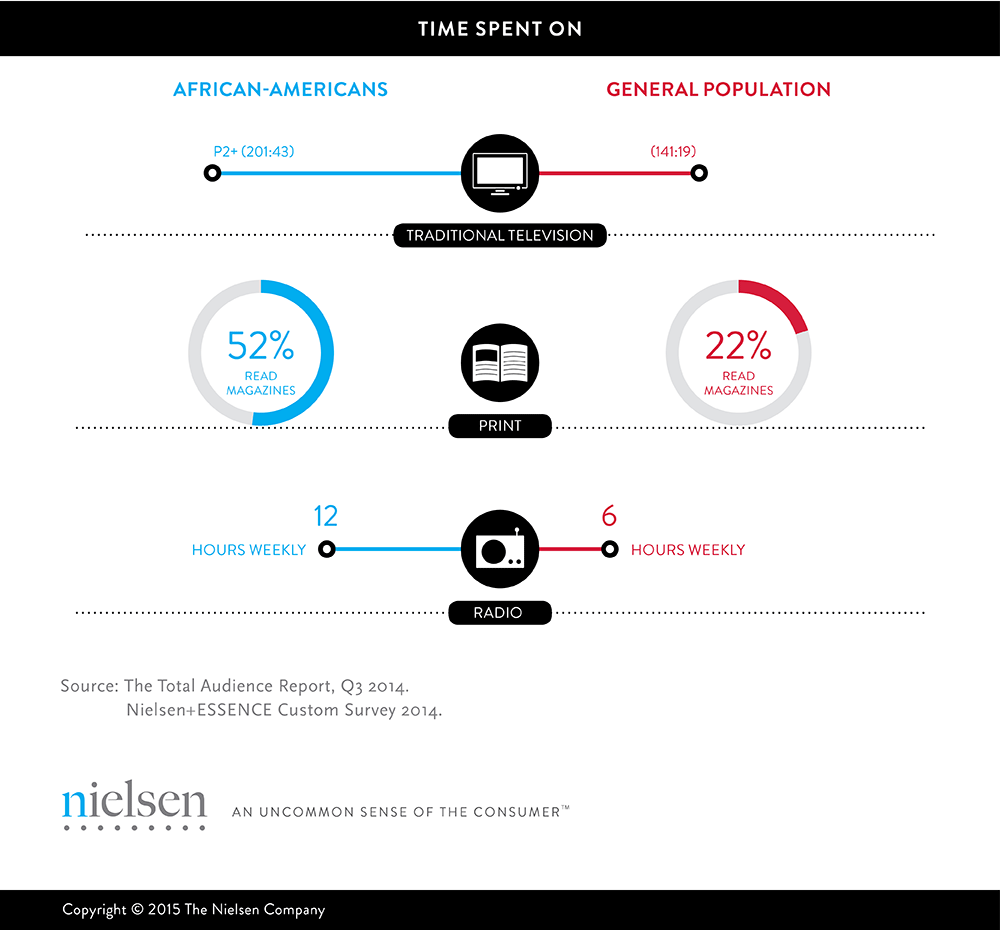African-Americans have a diverse approach to receiving content and information—they fully engage and connect through various mainstream and niche media outlets and platforms, and they consume more content than other groups on all fronts.
In a consumer marketplace cluttered with options, African-Americans aren’t shy about choosing the best-fit media outlets for news-gathering and entertainment purposes, reporting above-average consumption across each platform.

African-Americans watch the most television of any group, watching nearly 200 hours per month—roughly 60 more hours than the total audience! While blacks watch more real-time (i.e., live) television than other groups, levels of time-shifted and video-on-demand viewing are increasing as well, furthering the notion this group of consumers is multifaceted in their approach to viewing their favorite broadcast and cable programs.
During a time when digital is dominating news media consumption, African-American consumers still trust print. In fact, 52% of the black consumers Nielsen surveyed were more likely to be voracious readers of magazines, which is 30% higher than the general population.
Culture and heritage are drivers of preferred reading choices for blacks. Black readers have a strong connection with print mediums, which cater to these important elements. Among survey respondents, African-American-focused magazines and newspapers were important and provided information about products and deals. Fifty-nine percent of African-Americans agreed that advertisers in black newspapers, specifically, know how to connect with black audiences. Because of blacks’ strong affinity for culture-rich content, general-market outlets have established niche websites that offer a space for African-American-inspired stories on digital platforms.
Radio is another medium with high levels of connectivity for African-Americans. In a recent Nielsen report, where 10,000 African-American adults were surveyed, 92% said they tune into radio each week, listening for more than 12 hours, which is 5% longer than the total audience. Peak listening hours are between 10 a.m. and 3 p.m., with 61% of the listening occurring outside of the home.
Top-ranked radio formats for African-Americans with audiences that are more than 70% black are Urban Contemporary, Adult Urban Contemporary and Rhythmic Contemporary. Other formats with significant sway include Gospel and Urban oldies, which maintain 90% of black audiences. Culturally relevant topics and news, coupled with top-rated morning and afternoon programming, provide a substantial avenue for reaching black listeners.
African-American consumers have embraced technology, are avid users in this space and have become vocal mainstays in popular social media and blogging channels. Smartphone penetration is 81%, slightly edging the total population by 7%. On a monthly basis, blacks spend close to 56 hours using apps or mobile Internet browsers on their smartphones and about two and a half hours watching videos on their smartphones. Additionally, 81% of African-Americans are more likely to show support for a favorite company or brand using social media, and 76% are more likely to share opinions by posting reviews and ratings online.
For advertisers seeking to connect with African-Americans, a healthy mix of platforms can help amplify content and ensure that this group is receiving messages in a way it can engage with and share with peers—further extending brand reach. The use of multiple platforms allows marketers different touch points that are crucial, especially when making purchasing decisions.
METHODOLOGY
The insights in this article were derived from three sources.
- Nielsen+ESSENCE Custom Survey 2014: The custom data used in this report is composed of a collection of surveys. 1.) Survey of Adults 18+ that was collected from a nationally representative online panel, plus an additional oversample of African-Americans. 2.) Survey collected in person at the 2014 ESSENCE Festival in New Orleans. 3.) Interviews conducted in person at the 2014 ESSENCE Festival in New Orleans.
- Television Methodology: “On Traditional TV” includes live usage plus any playback viewing within the measurement period. Third-quarter 2014 television data is based on the following measurement interval: 06/30/14-09/28/14. As of February 2011, “DVR Playback” has been incorporated into the Persons Using Television (PUT) statistic.
- Mobile Methodology: Nielsen’s Electronic Mobile Measurement (EMM) is an observational, user-centric approach that uses passive metering technology on smartphones to track device and application usage on an opt-in convenience panel. Results are then reported out through Nielsen Mobile NetView 3.0. There are approximately 5,000 panelists in the U.S. across both iOS and Android smartphone devices.



